I woke up bright-eyed and bushy-tailed at 3am. Lovely. So I did my best to stay in bed with my eyes closed until a reasonable hour, but ended up getting up at 5 because I just couldn’t take it anymore.
Started my day with a phone call with Akira and another trip to Starbucks (I know, I know, it’s not Japanese, but it’s either Starbucks or McDonald’s at eight in the morning–nothing else around here is open then.) Then I was off to my day’s destination: Kamakura. It was supposed to take a little over an hour by train, with two transfers. I figured I could handle that.

The first train ride went smoothly. It was only two stops away to a relatively simple station, and I made my first transfer without incident. It was only after I was on the second train that I realized I’d hopped onto a local train rather than an express, meaning this train would be stopping at every. single. station between where I got on and Yokohama. Like, ten to fifteen stops. You’d think I’d remember from my other two trips to Japan that unless you need one of the smaller, local stations, always get on the express. Lesson learned.
It was my second transfer that gave me the trouble. Yokohama is a much bigger, more complicated station than the others I’d been dealing with up to this point. There were many different exits from the same platform, leading to different train lines and the subway. My first mistake was just following the flow of people and not looking carefully at which exit I’d need. So I took the wrong one. And once you’re through an exit, the only way back in is to buy another ticket. I didn’t want my mistake to cost me any money, even though it only would have been around 130 yen, so I decided to try finding another way.
That was my second mistake. I should have just bit the bullet and bought the ticket, but instead, my idea was to go outside the station and see if I could find an outdoor entrance that would lead to the area I needed. A sound idea, but not so great in practice. See, train stations aren’t just one giant building where you can circle the block and come in another way–they’re giant, often underground labyrinths, and some exits can put you several streets away from the station proper. That’s what happened to me.
There were no area maps near the exit I took, no wi-fi to connect to, and my phone wasn’t picking up any data signals either. So I walked in the general direction I thought the station to be in. For half an hour. In the sun and eighty-degree weather.
By then I was so completely lost that I couldn’t even retrace my steps anymore. I’d come across a few subway entrances (No way I was going to take any of those on a whim–those are more complicated than the train stations if you don’t know what you’re doing!) So I had to do things the old-fashioned way. I found somebody who was setting up a table in front of a store and asked for directions. Then, while following those directions, I got a little uncertain of where I was going, so I stopped and asked another person. Once I made it to the station, I asked a police officer how to get to Kamakura, and once inside the correct part of the station, I asked which line to take at the information booth. (Where was this before??) Thank goodness for my minimal Japanese skills. I’d probably still be wandering around in Yokohama somewhere without them.
Honestly, at that point I seriously considered just turning around and going back to the hotel. But I gave myself a stern pep talk, hopped on the train, and rode to Kamakura.
I’d left the first station at around nine and finally arrived in Kamakura at almost noon. Before heading to my first sightseeing spot, I stopped and grabbed some takoyaki (squid balls) for lunch. Then I headed up the hill to Hachimangu, Kamakura’s biggest, main Shinto shrine. It must have been school trip to Kamakura day, because the first thing I noticed on the street approaching the shrine was an influx of elementary school kids wearing their little yellow hats. (The hats help identify them and keep them together when out and about.) There were kids everywhere, giggling, calling to each other, dropping all manner of items (especially their money) on the ground, and generally being a lot more lively than you’d normally see at a shrine.

Hachimangu is one of the biggest shrines I’ve been to, with huge torii even at the side entrances and a large main shrine. One thing that’s unique about this particular shrine are its ema (votive plaques you can buy, write wishes on, and then dedicate to the shrine). They’re shaped like the leaves of a gingko tree.
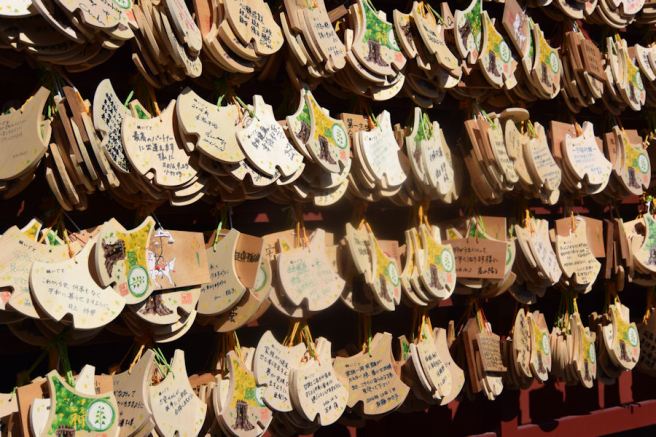
While I was exploring, I was approached by a group of about six school kids. These ones weren’t wearing yellow hats, which told me they were older than the others I’d been seeing everywhere. One of them was holding what looked like some kind of home-made phrase book, and she approached me pretty boldly and asked, “Excuse me? Can we take a picture–?”
I didn’t understand the last word she’d said, so I asked her to repeat herself. She and her friends looked nervously at each other, obviously unsure of what I’d said, so I switched to Japanese and tried again.
This time she understood and repeated herself: “Can we take a picture togezaa?” Aha!
“Oh, together? Uh, sure,” I said. So one of the other girls got out her camera, and the group gathered around me for a photo, a couple of the boys trying not to get too close. They thanked me profusely once the photo was taken, and I found out they were sixth-graders on a school trip. I’m guessing the photo was part of a sort of scavenger hunt. It seemed like they might have been filling out a checklist, and I bet talking to somebody in English was on it.
Next up (after a break for iced tea) were Hasedera and Kamakura’s Great Buddha, only a couple stops away on the local train. No trouble this time, though I was completely surrounded by yellow hats, standing room only, on this train.
I decided to go see Buddha first, so up the hill I went. Kamakura Daibutsu is the second-biggest Buddha statue in Japan. (The biggest is in Nara–I’ve seen that one, too, but my camera at the time wouldn’t take photos in the dim lighting inside the temple, so I don’t have any pictures of it.) What’s amazing about this particular Buddha is that since it was cast in 1252, it has survived a tsunami and an earthquake, both of which wiped out the temple that housed it. Since then it’s been left outside, and I think its oxidized bronze is beautiful.
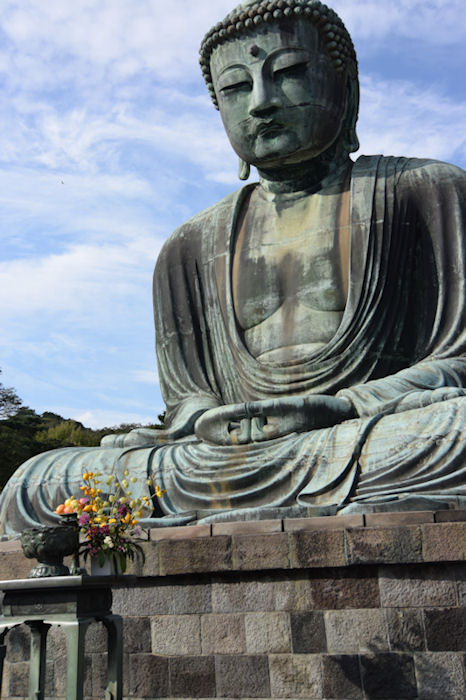
The other really cool thing about this particular Buddha? For twenty yen (less than 25 cents) you can actually go inside it. Yep. So of course I did.
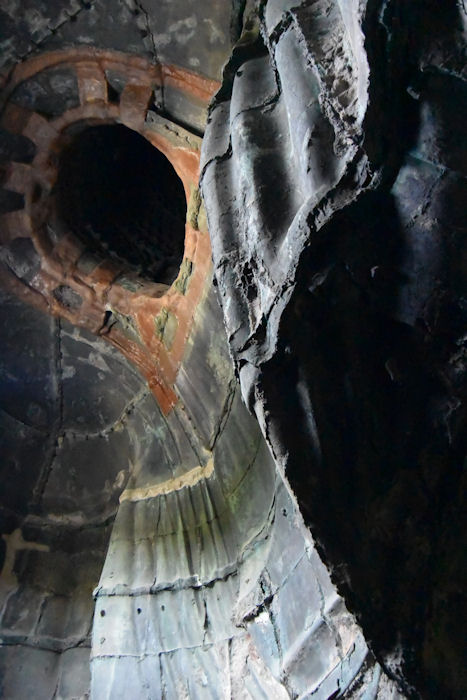
Besides the Buddha itself, I also had a good conversation with an elderly Japanese couple. My skills haven’t come back enough that I was able to think quickly and ask questions back, but at least I was able to answer the questions they asked me! Good practice.
My last stop of the day was Hasedera, a Buddhist temple dedicated to Kannon, the deity representing compassion, mercy, and love. I’ve been to quite a few Buddhist temples at this point, and Hasedera by far is my favorite. The grounds are gorgeous, complete with koi ponds, statues, and beautiful architecture. There’s a view of the ocean near the main hall, and even a cave you can walk through. The hillside behind the main hall is apparently covered with hydrangeas. I’ll have to come back someday to see them blooming.

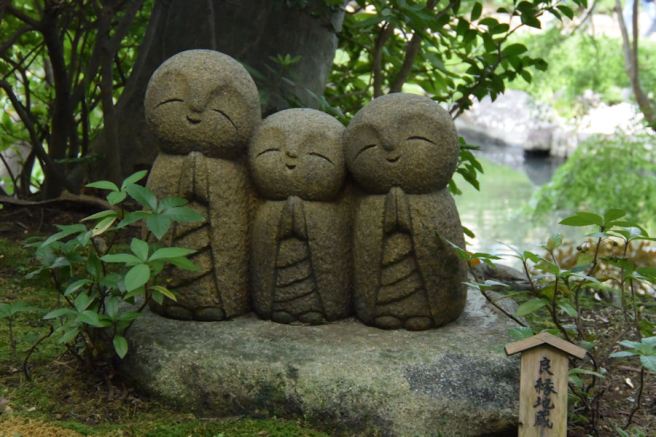
I was impacted at Hasedera more than I have been at any other temple before. This was especially true at one of the side halls. It housed Jizo, a Buddhist saint believed to be a protector of children. Here, thousands of small Jizo statues surround the hall, dedicated by parents whose children were miscarried, stillborn, or passed away before their time. That was heart-wrenching in itself, but if you approach the altar, you see children’s toys and clothes surrounding Jizo inside the hall.
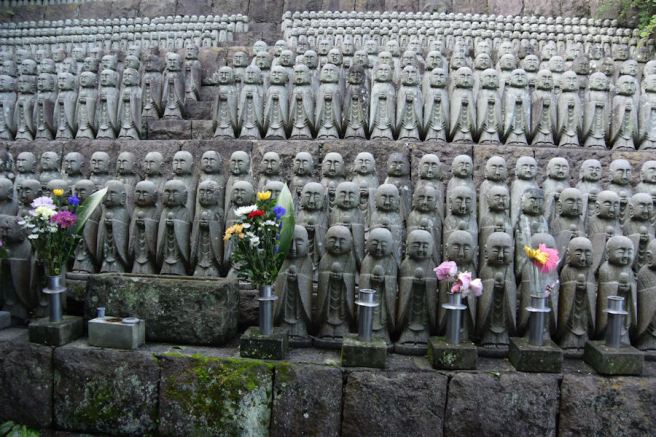
Off to one side of the main hall, there’s also a little Inari (Shinto god of rice and many others) shrine. This one was unique in that rather than having the usual wooden plaques as ema, this shrine had oyster shells. There is legend that the statue of Kannon now living at Hasedera floated to shore accompanied by oyster shells. Normally I don’t dedicate ema at shrines simply because I don’t feel I have anything to wish for, but the oyster shells reminded me of home, so I just had to this time.
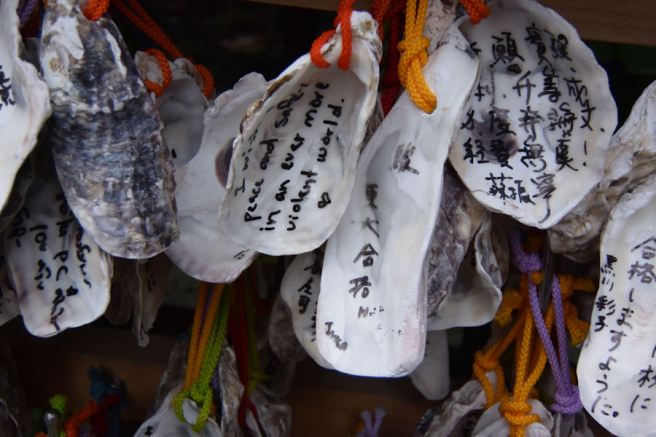
After a long day of being lost and hiking up and down hills and all sorts of stairs (Shrines and temples aren’t for the faint of heart or foot, by the way–lots of stairs. Lots. I will be back in shape by the time I come home.) I caught the train back to the hotel. No problems transferring, and even got on the express on the way back. See? Learning from my mistakes already.


what a great adventure so glad you didn’t give up
LikeLike